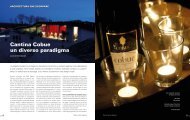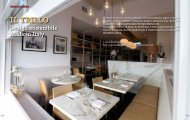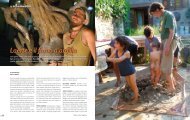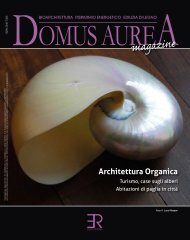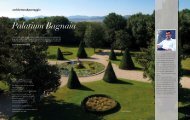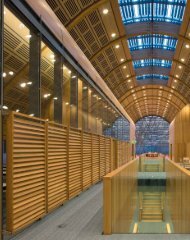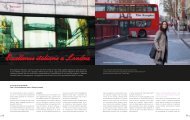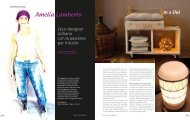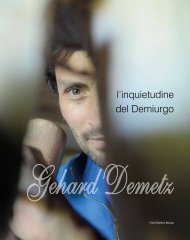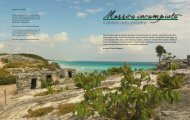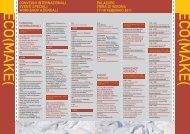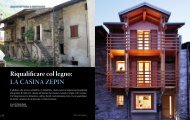le case farfalla -1 - Edizioni Rendi srl
le case farfalla -1 - Edizioni Rendi srl
le case farfalla -1 - Edizioni Rendi srl
You also want an ePaper? Increase the reach of your titles
YUMPU automatically turns print PDFs into web optimized ePapers that Google loves.
Dov’è finita l’architettura “capace di<br />
futuro”?<br />
di Beatrice Spirandelli<br />
Il concetto di sostenibilità in architettura<br />
può essere declinato in diversi modi: si<br />
parla fin troppo di risparmio energetico<br />
e troppo poco della opportunità di<br />
impiegare materie prime rinnovabili per<br />
qualunque tipo di costruzioni, mentre<br />
l’aspetto socia<strong>le</strong> che pure è insito in<br />
questo termine rimane sconosciuto ai<br />
più. è però ormai noto che lo standard<br />
di vita dei paesi più ricchi occidentali<br />
sta causando l’esaurimento del<strong>le</strong> preziose<br />
risorse che il pianeta ci mette a<br />
disposizione e che, oltre a cominciare a<br />
ridurre concretamente e non solo a paro<strong>le</strong><br />
questo spreco di risorse per tutte <strong>le</strong><br />
voci di consumo di casa nostra, bisognerebbe<br />
cercare di frenare la diffusione<br />
del nostro sti<strong>le</strong> di vita a tutte <strong>le</strong> zone<br />
del mondo. L’economia della decrescita,<br />
che molti propugnano come l’unica<br />
soluzione pacifica al<strong>le</strong> dinamiche di crisi<br />
internaziona<strong>le</strong> che stanno affliggendo<br />
In the fall of 2008 TYIN travel<strong>le</strong>d to Noh<br />
Bo, a small village on the Thai-Burmese<br />
border to design and build houses for<br />
Karen refugee children. The 60 year<br />
long conflict in Burma has forced several<br />
hundred thousand peop<strong>le</strong> to f<strong>le</strong>e<br />
from their homes. The conflict <strong>le</strong>aves<br />
many children orphaned, with litt<strong>le</strong> hope<br />
for the future.<br />
A few months earlier we got in touch with<br />
O<strong>le</strong> Jørgen Edna from Levanger, Norway.<br />
Edna started an orphanage in Noh Bo in<br />
2006, and was now in need of more dormitories.<br />
From sheltering 24 children, the<br />
orphanage would grow to house almost<br />
50. The Soe Ker Tie project was finished<br />
in February 2009.<br />
The main driving force behind the<br />
project was to somehow recreate what<br />
these children would have experienced<br />
in a more normal situation. We wanted<br />
every child to have their own private space,<br />
a home to live in and a neighbourhood<br />
where they could interact and play.<br />
These six s<strong>le</strong>eping units are our answer<br />
to this. Because of their appearance<br />
the buildings were named Soe Ker Tie<br />
Hias by the Karen-workers; The Butterfly<br />
Houses.<br />
The bamboo weaving technique used<br />
on the side and back facades is the<br />
same used in local houses and crafts.<br />
Most of the bamboo is harvested within<br />
a few kilometers of the site. The special<br />
roof shape of the Soe Ker Tie Houses<br />
enab<strong>le</strong>s an effective, natural ventilation,<br />
at the same time as it col<strong>le</strong>cts the rain<br />
water. This renders the areas around the<br />
buildings more useful during the rainy<br />
season giving the kids better areas for<br />
play and social life.<br />
The iron wood construction is prefabricated<br />
and assemb<strong>le</strong>d on-site, using<br />
bolts to ensure reasonab<strong>le</strong> precision and<br />
strength. By raising the buildings from<br />
the ground, on four foundations cast in<br />
old tires, prob<strong>le</strong>ms with moisture and rot<br />
in the construction are prevented. After a<br />
six month long mutual <strong>le</strong>arning process<br />
with the locals in Noh Bo we hope that<br />
we have <strong>le</strong>ft something useful behind and<br />
brought important experiences into our<br />
The Butterfly Houses<br />
coming projects. Important princip<strong>le</strong>s like<br />
bracing, material economization and<br />
moisture prevention may possibly <strong>le</strong>ad to<br />
an even more sustainab<strong>le</strong> building tradition<br />
for the Karen-peop<strong>le</strong> in the future.<br />
client: O<strong>le</strong> Jørgen Edna<br />
project: 6 s<strong>le</strong>eping units, orphanage<br />
cost: 12 300 USD<br />
time: November 2008 - February 2009<br />
architects:<br />
Pasi Aalto<br />
Andreas Grøntvedt Gjertsen<br />
Yashar Hanstad<br />
Magnus Henriksen<br />
Line Ramstad<br />
Er<strong>le</strong>nd Bauck So<strong>le</strong><br />
Postboks 8848<br />
7481 Throndheim<br />
Norway<br />
www.tyintegnestue.no<br />
www.youtube.com/tyintegnestue<br />
post@tyinarchitects.no<br />
18 19



